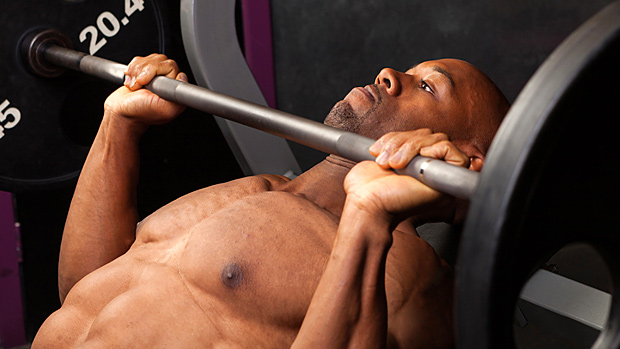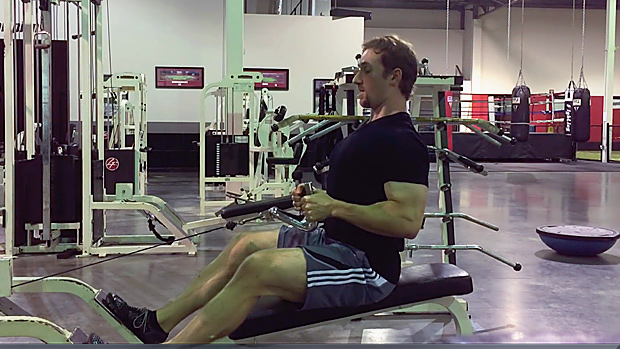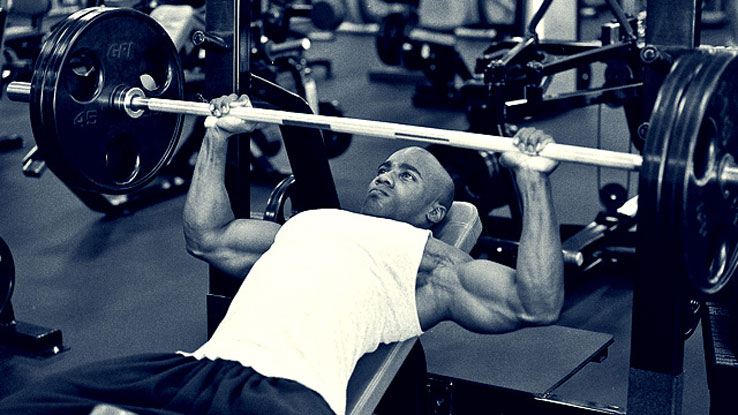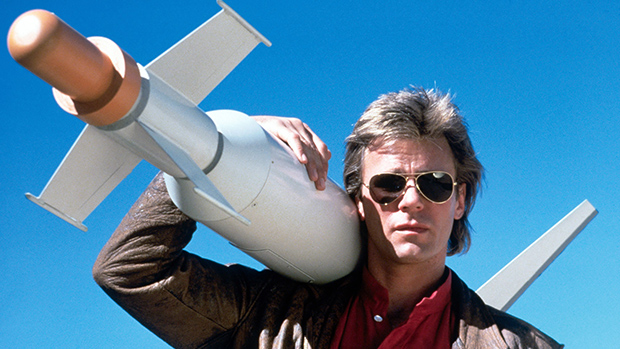The bench press is one of the "big" lifts. It's reached almost mythic status among lifters, and most would be gravely concerned if a potential training program didn't include it.
Many guys enjoy benching because it's a great way to get their man card from their gym buddies or get a much-needed ego boost every now and then. It's also a must for powerlifters since it's a third of their sport. And if you're training for the combine, you'd better be benching to prepare for the much-ballyhooed 225-pound rep-test.
But what about for field, court, and combat athletes looking to improve their overall performance?
Here at Performance U, we use the bench press, but we don't emphasize it as a pillar lift for athletes. The truth is, it isn't ideally suited for improving the standing pushing actions needed for optimal sports performance.
In this article I'll explain why we feel the bench press is one of the most overemphasized and misunderstood exercises in the sports performance world. I'll also show you three bench pressing alternatives that don't get the love they deserve.
First, please don't get your bench shirts in a bunch. I'm certainly not trying to tell you to quit bench pressing, especially if you're a powerlifter or if you just happen to enjoy doing it.
I'm simply sharing our particular training approach, which uses the bench press in a different manner than what you may be familiar with while providing some insight on how to best fit the bench press into your sports-strength program.
We certainly don't claim to have all the answers – we're just sharing the methods that have worked best for us.
How can we challenge the bench press when it's helped so many high school, college, and pro athletes?
The bench press is one of those exercises that most folks don't bother to challenge because it's just been around so long.
But when you apply some good old-fashioned logic to those arguments suggesting that the bench press plays a crucial role in developing teen athletes, it reveals several important elements that have a much greater impact on athletic success than the little ol' bench press.
High school kids are on a four-year cycle of natural anabolic steroids!
High school boys aged 12-17 will get bigger and stronger no matter what they do because they've got a serious anabolic advantage. When teenaged boys go through puberty (especially the latter stages), they get what's called the "strength spurt," in which their body drastically increases Testosterone production, bone thickness, muscle mass, and motor unit recruitment while decreasing body fat. And it all happens within a few short years.
A good strength program can surely teach teenagers good lifting habits and help them build a solid work ethic. Furthermore, a resistance-training program will accelerate strength gains. But in all likelihood, any strength-training stimulus will have a similar effect when you're on such a powerful cast of supportive androgens.
All field, court, and combat athletes reach the highest levels because they're the best at playing their sport – not because they're the best in the gym!
All you need to do is look at the NFL combine results for proof. Out of the top five bench press records in NFL Combine history, only one player, Brodrick Bunkley (Florida State, 2006) became a remotely successful player.
The 2008 article titled, "Few recent combine stars have become productive NFL players" stated that:
"Seventeen of the 128 very best combine performers since 2000 went undrafted. Twelve of them never played in an NFL game. Forty-three weren't in the NFL last season. Ninety-five have started fewer than half of their potential regular-season games since they shined at the combine."
And from the "10 Greatest Scouting Combine Performances in NFL History," half the names on the list never panned out into even halfway decent players. However, the other half of the names on the list became superstars.
All these athletes had "raw" physical ability, but what separated the zeros from the NFL heroes was their ability to use that talent as a platform to express their will and skill to actually play the game.
In other words, physical ability is meaningless if you stink at your sport! And physical training will just make you a bigger, stronger, faster dude who still happens to stink at his sport. It's your skill and your will that makes you a winner.
It's for these reasons that we feel it's completely unrealistic to credit any particular workout program, much less a specific exercise like the bench press, for the success an athlete achieves.
Strength and conditioning gives you the physical fitness to do what you already know how to do. But running faster doesn't help if you're running to the wrong spot on the field, and strength doesn't help if you miss a block or push your opponent in the wrong direction.
If there's any credit to be given to a strength and conditioning program, it's for simply helping an athlete to get more gas in the tank (the conditioning) to express their skill and their will throughout the competition.
Does the bench press carry over into better standing pushing strength?
In 2007, Coach Juan Carlos Santana and Dr. Stuart McGill conducted a kinetic and electromyographic comparison of the standing cable press and bench press.
"This study compared the single arm standing cable press and the traditional bench press to better understand the biomechanical limitations of pushing from a standing position together with the activation amplitudes of trunk and shoulder muscles."
Here's what we consider to be the biggest finding from this study:
- Pushing forces from a standing position under ideal mechanical conditions are limited to 40.8% of the subject's body weight.
- Our EMG findings show that standing cable press performance is limited by the activation and neuromuscular coordination of torso muscles, not maximal muscle activation of the chest and shoulder muscles.
- Both these results reveal what common sense tells us anyway.
First, it's unnecessary for a field, court, or combat athlete (who's not training for a combine) to worry about maximal bench press strength. The principles of mathematics and physics make it impossible for anyone to even come close to matching that kind of pushing force from a standing position, regardless of the stance you're in.
Second, the limiting factor when pushing from a standing position is the stiffness of the torso muscles to maintain your body position and to coordinate the hips and shoulders while stabilizing the forces the extremities (arms and legs) create.
In other words, the standing pushing action is more of a whole body exercise, whereas the bench press is more just an upper-body exercise.
Note: I realize that powerlifters use their hips and lower back to aid in their bench press performance. But they're also lying down and have their shoulders anchored on the bench. So it's still comparing apples to oranges.
The JCS and McGill study abstract concludes with this statement:
"The single arm standing cable press performance also relies on the strength of shoulder and chest musculature; however, it's whole-body stability and equilibrium together with joint stability that present the major limitation in force generation. This has implications for the utility of these exercise approaches to achieve different training goals."
So to improve standing pushing performance, we've got to use standing pushing exercises. Or use pushing exercises that create whole body stability, which integrate the hips and core along with the upper-body.
Here at Performance U, we classify exercises as either "general" or "functional." I'll explain the difference between the two and how we use both in the next section.
For now, check out our three favorite "functional" pushing exercises, which all perfectly fit the criteria described above, namely, each of these moves creates a core-limited, whole-body training stimulus. It's also why the following exercises are higher up on our training food chain than the bench press.
One-Arm Push-Ups
The one-arm push-up is our single favorite whole-body pushing exercise. In fact, it's what's dethroned the bench press as our new king of upper-body pushing exercises and it's what we use to gauge an athlete's pushing strength.
Generally, if you're a big dude that can crank out 4-6+ full range one-arm push-ups, you're a stud in our books. For smaller guys, you've got to do at least 7-10+ for us to give you your man card.
Although the one arm push up isn't performed from a standing position, it still heavily involves the core, hips, and lower body. When performing one-armed push-ups, you're promoting unilateral strength, which builds better left/right side muscle balance and brings in more core activation.
But you're also training the "serape effect," which is the force production relationship between your shoulder and opposite hip (through the torso) that's responsible for actions like running, throwing, punching, etc.
Here's how we teach our athletes to perform one-arm push-ups:
Once you've become proficient at doing one-arm push-ups from the floor, you can progress to using a weighted vest and/or the foot-elevated version that I'm showing off here:
Note: Check out my Everything Push Ups article for the exercise progressions we use to build up to doing one-arm push-ups.
Standing One-Arm Cable Press
If you can't do one-arm push-ups, or you're currently working up to doing them, the standing one-arm cable press is a great training option.
Most of the time we see folks using this exercise the weight is too light to create an effective strength challenge. That's a mistake.
Check out the video because there's several key strategies we've developed to help our athletes perform this exercise safely and effectively using a challenging load!
Angled Barbell Presses
The angled barbell press makes a nice complement to one-arm push-ups or standing cable presses as the pushing angle is different. Therefore, it helps create full-spectrum functional pushing strength in multiple angles.
In sports you're not always pushing straight ahead but slightly upward, such as when trying to control an opponent's shoulders in MMA or getting underneath a players shoulder pads in football. This is a great exercise to help you perform those actions.
As I said above, we classify exercises as either "functional" or "general." And we use both general and functional exercises in every sports performance workout we do to ensure our programs are fully comprehensive and maximally effective.
I'll admit it's not a perfect classification system because both types of exercises can improve functional performance. But it's the best system we've come up with to date, and it hasn't failed us yet. So, don't get too caught up in the terms and focus on the concepts.
General Exercises
We use "general exercises" like the bench press, incline press, dumbbell press, and a multitude of push up variations to indirectly help functional performance by increasing muscle mass, motor unit recruitment, bone density, and connective tissue health.
Functional Exercises
We use "functional exercises" like the ones shown above to replicate the specific force production patterns involved in standing pushing movements to improve the neuromuscular coordination involved with performing those patterns.
Some people might rather call these "special strength" or "specific strength" exercises if they're into the three-tier eastern block stuff. For us, we like to stick with the two categories as stated above.
Anytime the words "functional training" come up, the typical strength training enthusiast's reply is something like, "Don't worry about making the exercise look like the sports movement – just get strong and you'll be more functional."
Improving strength does make you more functional, which is why we use many "general strength" exercises. And we also agree that the bench press is a great way to improve upper-body strength – which is why we use it.
But let's discuss what some coaches would have me do if they wanted to improve my bench press.
They'd have me bench press often, and we'd do lots of bench press variations like close grip presses, wide grip presses, fat bar presses, 2 or 3-board presses, pin presses, and use chains/band, etc., in various speeds, loads, and rep ranges.
These exercises are all commonly called "assistance exercises" because they assist in improving the bench press by training various components of the lift. They also replicate the specific force production patterns of the bench press.
The funny thing is that all these assistance exercises happen to look just like the bench press. The same applies for assistance exercises used to increase the squat or deadlift – they all look like the movement they're supposed to be "assisting."
So to improve my bench press, I should do lots of stuff that's similar to the bench press action – surely you don't believe that using assistance exercises to improve performance only applies to the squat, deadlift and bench press?
What we do is apply this same logic towards assistance exercises to what we call our "functional exercises." In the context of this article, you could call the exercises provided above "assistance exercises" for the standing pushing action.
In this article I've given you theoretical, logical, scientific and practical reasons for why we do what we do to help our field, court, and combat athletes to improve their standing functional pushing strength.
To help you better understand the concepts discussed in this article, here's a quick review of the key points:
- The bench press may not be an accurate method of gauging an athletes functional standing pushing strength. The two actions involve very different force production and neuromuscular coordination patterns.
- The limiting factor in the bench press is upper-body strength. But the limiting factor in the standing press actions common in sports is the coordination of your torso to create whole-body stiffness and allow your extremities (legs and arms) to create high pushing forces.
- It's mathematically and physically impossible for anyone to match, or even come close to replicating what they can bench press in a push from a standing position. Which, (to us) makes maximal bench press efforts an unnecessary training risk for athletes to perform. That's why when we do bench press, we stay above six reps.
- The bench press can certainly help athletes as a general strengthening exercise along with many other traditional pressing exercises. And exercises like one-arm push-ups, one-arm cable presses, and angled barbell press make great specific/functional exercises to complement the general exercises.
- The one-arm push-up makes a great functional replacement for the bench press as a means to gauge strength and progress.
- If you can't do one-arm push-ups or just don't like doing them, angled barbell presses and standing single-arm cable presses will get the job done. But one-arm push-ups are still king in our book.
- A good strength program uses both general and functional strength exercises.
- Regardless of how great your strength program is, it won't do much good if you lack the will, skills, and instincts to play your sport!





